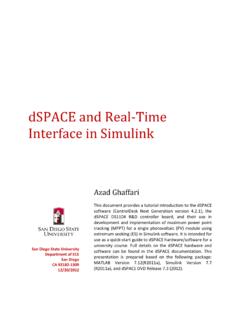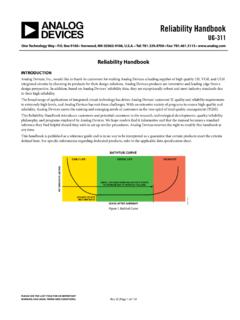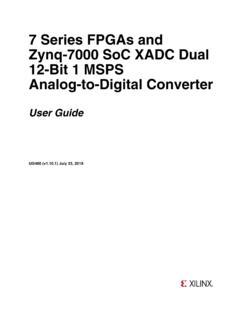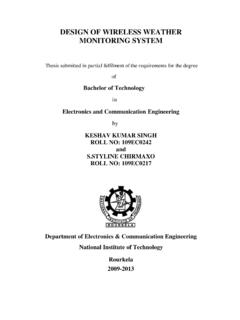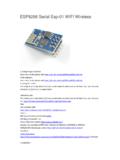Transcription of AWR1642 mmWave sensor - Analog, Embedded …
1 AWR1642 mmWave sensor :76 81-GHz radar-on-chip for short-range radar applicationsJasbir SinghSoC ArchitectBrian GinsburgmmWave Systems ManagerSandeep RaoRadar Systems ArchitectKarthik RamasubramanianRadar Systems ManagerTexas InstrumentsAWR1642 mmWave sensor : 2 May 201776 81-GHz radar-on-chip for short-range radar applicationsIntroductionThe use of radar technology has grown tremendously in recent years. In the automotive context, the primary radar applications can be broadly grouped into corner radars and front radars.
2 Corner radars (rear and front) are typically short-range radar sensors that handle the requirements of blind-spot detection (BSD), lane-change assist (LCA) and front/rear cross-traffic alert (F/RCTA), while front radars are typically mid- and long-range radars responsible for autonomous emergency braking (AEB) and adaptive cruise control (ACC).Traditionally, corner radars were based on 24-GHz technology. However, there is a shift in the industry toward the 77-GHz frequency band due to emerging regulatory requirements, as well as the larger bandwidth availability, smaller sensor size and performance white paper introduces the AWR1642 device as a highly integrated 76 81-GHz radar-on-chip solution for short-range radars.
3 The device comprises the entire millimeter wave ( mmWave ) radio-frequency (RF) and analog baseband signal chain for two transmitters (TX) and four receivers (RX), as well as two customer-programmable processor cores in the form of a C674x digital signal processor (DSP) and an ARM Cortex -R4F microcontroller (MCU). In the next few sections, we will present the high-level architecture and features of the AWR1642 device and show sample illustrations of chirp configurations for typical use high-level architectureThe AWR1642 device is a highly integrated single-chip 77-GHz radar-on-chip device that includes two transmit and four receive chains, a 600-MHz user-programmable C674x DSP and a 200-MHz user-programmable ARM Cortex-R4F processor.
4 The device supports wide RF bandwidth, covering both the 76 77-GHz and 77 81-GHz bands. As Figure 1 on the following page shows, the device comprises four main subsystems: the RF/ analog subsystem, the radio processor subsystem, the DSP subsystem and the master subsystem. The RF/ analog subsystem includes the RF and analog circuitry: the synthesizer, power amplifiers (PAs), low-noise amplifiers (LNAs), mixers, intermediate frequency (IF) chains and analog -to-digital converters (ADCs). This subsystem also includes crystal oscillators, temperature sensors, voltage monitors and a general-purpose AWR1642 device uses a complex baseband architecture and provides in-phase (I-channel) and quadrature (Q-channel) outputs.
5 A separate white paper titled Using a complex-baseband architecture in FMCW radar systems describes the advantages of a complex-baseband mmWave sensor : 3 May 201776 81-GHz radar-on-chip for short-range radar applicationsThe radio processor subsystem (also known as the built-in self-test [BIST] subsystem) includes the digital front-end, the ramp generator and an internal processor for controlling and configuring low-level RF/ analog and ramp generator registers based on well-defined application programming interface (API) messages from the master or DSP subsystem.
6 (Note: this radio processor is TI-programmed and takes care of RF calibration needs and BIST/monitoring functions; the processor is not available directly for customer use.) The digital front end takes care of filtering and decimating the raw sigma-delta ADC output and provides the final ADC data samples at a programmable sampling DSP subsystem includes a TI C674x DSP clocked at 600 MHz for radar signal processing typically the processing of raw ADC data until object detection. This DSP is customer-programmable, and enables full flexibility when using proprietary master subsystem includes ARM s automotive-grade Cortex-R4F processor clocked at 200 MHz, which is customer-programmable.
7 This processor controls the overall operation of the device, handles the communication interfaces, and typically implements higher-layer algorithms such as object classification and tracking. This processor can run Automotive Open System Architecture (AUTOSAR) if AWR1642 mmWave sensor can function as an autonomous radar-on-chip sensor for short-range radar (SRR) applications. The device includes a Quad Serial Peripheral Interface (QSPI), which can download customer code directly from a serial Flash. A Controller Area Network-Flexible Data Rate (CAN-FD) interface and an additional (classic) CAN interface are included so that the sensor can communicate directly with the vehicle CAN bus or with other sensors on a private CAN bus.
8 An SPI/Inter-Integrated Circuit (I2C) interface is available for power-management integrated circuit (PMIC) control when using the AWR1642 device as an autonomous (Decimationfilter chain)LNAIFADCLNAIFADCLNAIFADCLNAPAPAS ynth(20 GHz) (BIST)processor(For RF Calibrationand Self-test TIprogrammed)ProgRAMand ROMDataRAMGPADCVMONTempCortex-R4 Fat 200 MHz(Userprogrammable)ProgRAM(256kB*)Data RAM(192kB*)BootROMQSPISPISPI /I2 CDebugUARTsDCANDMATest/DebugADCB ufferLVDSRF/AnalogsubsystemRadioprocesso rsubsystem(TI programmed)Mastersubsystem(Customerprogr ammed)SerialflashinterfaceOptionalExtern alMCUinterfacePMIC controlPrimarycommunicationinterfaces(au tomotive)For debugJTAG for debug/developmentHigh-speedADCoutputinte rface(for recording)*Upto 512 KBof RadarDataMemorycan be switchedto the MasterR4 Fif required6 CAN-FDDSP subsystem(Customerprogrammed)
9 MailboxBus MatrixHILHigh-speedinputforhardware-in-l oopverificationC674xDSPat 600 MHzL1P(32kB)L1D(32kB)L2(256kB)DMACRCR adarDataMemory(L3)768 kB*Figure 1. AWR1642 high-level mmWave sensor : 4 May 201776 81-GHz radar-on-chip for short-range radar applicationsMemory partitionThe total memory available on the AWR1642 mmWave sensor is MB. This is partitioned between the R4F program RAM, R4F data RAM, DSP L1 and L2 memory and radar data memory (L3 memory). Table 1 lists some example memory configurations. The L2 memory in the DSP subsystem is 256 KB and typically used for instruction and immediate data for the DSP application.
10 The DSP subsystem also includes 32 KB each of L1 program and data RAMs, which are configurable as cache, either in full or partially. The R4F has dedicated memory of 448 KB, which is partitioned between the R4F s tightly coupled memory interfaces viz., TCMA (256 KB) and TCMB (192 KB). Although the complete 448-KB memory is unified and useable for instruction or data, typical applications use TCMA as instruction memory and TCMB as data memory. The remaining 768 KB is L3 memory, which is available as radar data cube memory.










